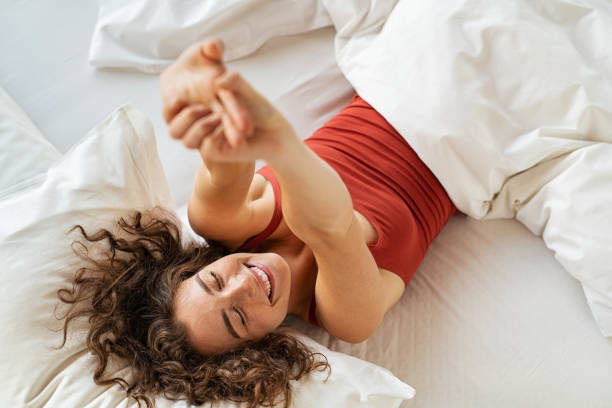Restless nights are often caused by stress and anxiety. When our body’s stress response is on high alert, falling asleep becomes a challenge. Thankfully, research shows we can counteract this by activating the relaxation response, a natural state that promotes calmness and sleepiness.
Breathing exercises for relaxation
Slow, deep breaths are a simple and powerful tool to engage your relaxation response. Start with 10 deep breaths to slow your breathing and ease into a calmer state. Here are two specific breathing exercises to explore:
- Diaphragmatic Breathing: This technique uses the diaphragm, the large muscle below your lungs, for more efficient breathing.
- Lie down and place one hand on your chest, the other on your belly.
- Inhale through your nose, feeling your belly push against your hand.
- Exhale by tightening your stomach muscles, keeping your chest still.
- Repeat.
- 4-7-8 Breathing: This exercise controls your breath rate and may not be suitable for everyone, but it’s generally safe and easy to learn.
- Inhale through your nose for a count of 4 seconds.
- Hold your breath for 7 seconds.
- Exhale completely through your mouth for 8 seconds.
- Repeat.
Visualization for relaxation
Visualization exercises use mental imagery to create a sense of peace and well-being, reducing stress and promoting sleep. Here are two techniques to try:
- Meditation: This involves focusing your attention on different parts of your body, one by one, releasing any tension you find.
- Lie comfortably and take a few deep breaths.
- Start with your feet, noticing any sensations and tension.
- Acknowledge discomfort and visualize it leaving with each exhale.
- Slowly move your attention up your body, repeating the process.
Progressive Muscle Relaxation
This technique involves tensing and relaxing different muscle groups one by one, helping to release physical tension.
- Lie down comfortably and tense your toes and feet for 5-10 seconds.
- Breathe out and relax your feet.
- Stay relaxed for 10-20 seconds before moving to your next muscle group (legs, thighs, hips, etc.)
- Continue systematically tensing and relaxing each muscle group throughout your body.
Non-Sleep Deep Rest (NSDR)
NSDR is a state of conscious relaxation similar to self-hypnosis. While still awake, NSDR allows your body to rest and restore energy. It’s not meant to induce sleep but can be a helpful pre-sleep meditation technique.
- Lie comfortably with your eyes closed, focusing on relaxing your body.
- Breathe slowly and deeply, imagining yourself sinking deeper into relaxation.
- Stay focused and avoid letting your mind wander.
Tips for Success
- Practice Makes Perfect: Relaxation techniques become more effective with regular use.
- Find What Works: Experiment with different techniques until you find what works best for you.
- Get Out of Bed: If you can’t fall asleep after 15 minutes of relaxation techniques, get out of bed and do a calming activity elsewhere.
- Optimize Your Sleep Environment: Ensure your bedroom is quiet, dark, and cool.
- Healthy Habits: Maintain a consistent sleep schedule, avoid caffeine and heavy meals before bed, and create a relaxing bedtime routine.
Remember, while these exercises are generally safe, consult your doctor before trying them if you have epilepsy, psychiatric conditions, or a history of trauma.
By incorporating relaxation techniques into your routine, you can combat stress, improve sleep quality, and wake up feeling refreshed and ready to take on the day.
